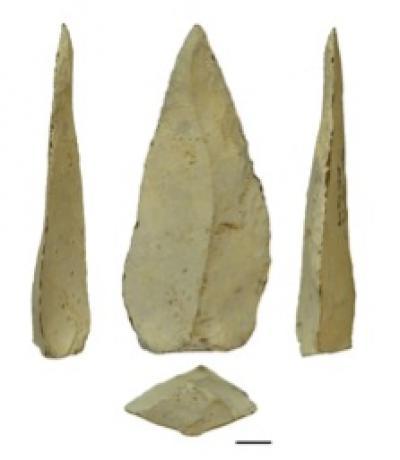Attaching stone points to spears - hafting - was an important advance in hunting for our early ancestors. Though hafted tools require a great deal of effort to manufacture, a sharp stone point on the end of a spear can increase its killing power and that shows strategic foresight.
Hafted spear tips became common in Stone Age archaeological sites around 300,000 years ago but this new development shows that hafted spear tips were also used in the early Middle Pleistocene, a period associated with Homo heidelbergensis, the last common ancestor of Neanderthals and modern humans.

An approximately 500,000-year-old point from Kathu Pan 1. Multiple lines of evidence indicate that points from Kathu Pan 1 were used as hafted spear tips. Scale bar = 1 cm. Credit: Jayne Wilkins
"There is a reason that modern bow-hunters tip their arrows with razor-sharp edges. These cutting tips are extremely lethal when compared to the effects from a sharpened stick. Early humans learned this fact earlier than previously thought," said Benjamin Schoville, a co-author of this study affiliated with the Institute of Human Origins at Arizona State University. "Rather than being invented twice, or by one group learning from the other, stone-tipped spear technology was in place much earlier. Although both Neandertals and humans used stone-tipped spears, this is the first evidence that this technology originated prior to or near the divergence of these two species."
"It now looks like some of the traits that we associate with modern humans and our nearest relatives can be traced further back in our lineage," said Jayne Wilkins of the University of Toronto, lead author of the paper. "This changes the way we think about early human adaptations and capacities before the origin of our own species."
Point function was determined by comparing wear on the ancient points to damage inflicted on modern experimental points used to spear a springbok carcass target with a calibrated crossbow. This method has been used effectively to study weaponry from more recent contexts in the Middle East and southern Africa.
"When points are used as spear tips, there is a lot of damage that forms at the tip of the point, and large distinctive fractures form. The damage on these ancient stone spear points is remarkably similar to those produced with our calibrated crossbow experiment, and we demonstrate they are not easily created from other processes," said coauthor Kyle Brown, a skilled stone tool replicator from the University of Cape Town.
The points were recovered during 1979 excavations by Peter Beaumont of the McGregor Museum, Kimberly, South Africa.
In 2010, a team directed by coauthor Michael Chazan from the University of Toronto reported that the point-bearing deposits at KP1 dated to around 500,000 years ago using optically stimulated luminescence and U-series/electron spin resonance methods. The dating analyses were carried out by Naomi Porat, Geological Survey of Israel, and Rainer Grün, Australian National University.
Published in Science.





Comments